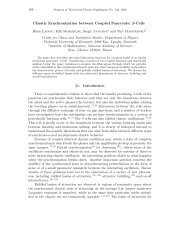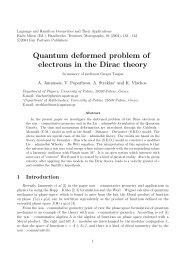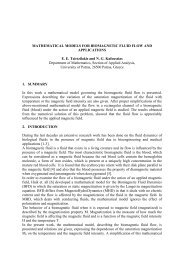- Page 2 and 3: DIFFERENTIAL EQUATIONS, DYNAMICAL S
- Page 4 and 5: DIFFERENTIAL EQUATIONS, DYNAMICAL S
- Page 6 and 7: Preface x Contents CHAPTER 1 First-
- Page 8 and 9: CHAPTER 9 Global Nonlinear Techniqu
- Page 10 and 11: Bibliography 407 Index 411 17.3 Con
- Page 14 and 15: Preface xiii We then return to nonl
- Page 16 and 17: 1 First-Order Equations The purpose
- Page 18 and 19: 1.1 The Simplest Example 3 qualitat
- Page 20 and 21: Therefore the logistic equation red
- Page 22 and 23: 0.8 1.3 Constant Harvesting and Bif
- Page 24 and 25: x 1.4 Periodic Harvesting and Perio
- Page 26 and 27: 1.4 Periodic Harvesting and Periodi
- Page 28 and 29: 1.5 Computing the Poincaré Map 13
- Page 30 and 31: 1 1.6 Exploration: A Two-Parameter
- Page 32 and 33: Exercises 17 (a) Sketch the phase l
- Page 34 and 35: for all t. Suppose there are consta
- Page 36 and 37: 2 Planar Linear Systems In this cha
- Page 38 and 39: 2.1 Second-Order Differential Equat
- Page 40 and 41: Example. The curve x(t) = y(t) fo
- Page 42 and 43: 2.3 Preliminaries from Algebra 27 w
- Page 44 and 45: (1/2, 1/2), because 1 0 0 1 = 1
- Page 46 and 47: 2.5 Eigenvalues and Eigenvectors 31
- Page 48 and 49: 2.6 Solving Linear Systems 33 or
- Page 50 and 51: We therefore have shown the followi
- Page 52 and 53: 1. 2. 3. 4. Figure 2.2 Match these
- Page 54 and 55: 3 Phase Portraits for Planar System
- Page 56 and 57: 3.1 Real Distinct Eigenvalues 41 sy
- Page 58 and 59: 3.1 Real Distinct Eigenvalues 43 (a
- Page 60 and 61: to λ = iβ. We therefore solve
- Page 62 and 63:
3.3 Repeated Eigenvalues 47 Example
- Page 64 and 65:
Thus, if y = 0, we must have y(t) =
- Page 66 and 67:
3.4 Changing Coordinates 51 serves
- Page 68 and 69:
Finally, we compute T −1 AT = 3.4
- Page 70 and 71:
3.4 Changing Coordinates 55 α > 0.
- Page 72 and 73:
Exercises 57 for some constants μ,
- Page 74 and 75:
Exercises 59 (a) For which values o
- Page 76 and 77:
4 Classification of Planar Systems
- Page 78 and 79:
Thus we have 4.1 The Trace-Determin
- Page 80 and 81:
4.2 Dynamical Classification 65 We
- Page 82 and 83:
4.2 Dynamical Classification 67 2.
- Page 84 and 85:
t A r (x, y) S 1 4.2 Dynamical Clas
- Page 86 and 87:
4.3 Exploration: A 3D Parameter Spa
- Page 88 and 89:
Exercises 73 6. Prove that any two
- Page 90 and 91:
5 Higher Dimensional Linear Algebra
- Page 92 and 93:
5.1 Preliminaries from Linear Algeb
- Page 94 and 95:
5.1 Preliminaries from Linear Algeb
- Page 96 and 97:
5.1 Preliminaries from Linear Algeb
- Page 98 and 99:
5.2 Eigenvalues and Eigenvectors 83
- Page 100 and 101:
5.2 Eigenvalues and Eigenvectors 85
- Page 102 and 103:
Let V denote the complex conjugate
- Page 104 and 105:
Therefore the matrix associated to
- Page 106 and 107:
By the previous observation, the sy
- Page 108 and 109:
5.4 Bases and Subspaces 93 Hence th
- Page 110 and 111:
5.5 Repeated Eigenvalues 95 linearl
- Page 112 and 113:
5.5 Repeated Eigenvalues 97 A −
- Page 114 and 115:
5.5 Repeated Eigenvalues 99 an exer
- Page 116 and 117:
The characteristic equation for A i
- Page 118 and 119:
5.6 Genericity 103 that we can find
- Page 120 and 121:
5. Put the following matrices in ca
- Page 122 and 123:
6 Higher Dimensional Linear Systems
- Page 124 and 125:
x z y 6.1 Distinct Eigenvalues 109
- Page 126 and 127:
where αj βj Bj = 6.1 Distinct Ei
- Page 128 and 129:
Figure 6.4 A spiral saddle in canon
- Page 130 and 131:
6.2 Harmonic Oscillators 115 We cou
- Page 132 and 133:
Restricted to this torus, the equat
- Page 134 and 135:
6.3 Repeated Eigenvalues 119 in the
- Page 136 and 137:
Solving as above, we find Altogethe
- Page 138 and 139:
6.4 The Exponential of a Matrix 6.4
- Page 140 and 141:
6.4 The Exponential of a Matrix 125
- Page 142 and 143:
and ⎛ m αm = ⎝ j=0 6.4 The Exp
- Page 144 and 145:
6.4 The Exponential of a Matrix 129
- Page 146 and 147:
6.5 Nonautonomous Linear Systems 13
- Page 148 and 149:
6.5 Nonautonomous Linear Systems 13
- Page 150 and 151:
Exercises 135 and using the fact th
- Page 152 and 153:
k 1 m 1 k 2 m 2 k 1 Figure 6.10 A c
- Page 154 and 155:
7 Nonlinear Systems In this chapter
- Page 156 and 157:
7.1 Dynamical Systems 141 “trajec
- Page 158 and 159:
7.2 The Existence and Uniqueness Th
- Page 160 and 161:
7.2 The Existence and Uniqueness Th
- Page 162 and 163:
7.3 Continuous Dependence of Soluti
- Page 164 and 165:
7.4 The Variational Equation 149 Th
- Page 166 and 167:
nonautonomous linear equation 7.4 T
- Page 168 and 169:
7.5 Exploration: Numerical Methods
- Page 170 and 171:
7.5 Exploration: Numerical Methods
- Page 172 and 173:
Exercises 157 8. Construct an examp
- Page 174 and 175:
8 Equilibria in Nonlinear Systems T
- Page 176 and 177:
8.1 Some Illustrative Examples 161
- Page 178 and 179:
8.1 Some Illustrative Examples 163
- Page 180 and 181:
8.2 Nonlinear Sinks and Sources 165
- Page 182 and 183:
The linearized system is now given
- Page 184 and 185:
8.3 Saddles 169 satisfies −μ < 0
- Page 186 and 187:
8.3 Saddles 171 Let C + M denote th
- Page 188 and 189:
8.3 Saddles 173 if η(0) =−1, the
- Page 190 and 191:
x W s (0) zW u (0) Figure 8.5 The p
- Page 192 and 193:
8.5 Bifurcations 177 has a single e
- Page 194 and 195:
x x 0 Figure 8.6 The bifurcation di
- Page 196 and 197:
8.5 Bifurcations 181 We denote thes
- Page 198 and 199:
8.6 Exploration: Complex Vector Fie
- Page 200 and 201:
Exercises 185 (b) Describe the phas
- Page 202 and 203:
Exercises 187 12. In the definition
- Page 204 and 205:
9 Global Nonlinear Techniques In th
- Page 206 and 207:
A D C (a) B 9.1 Nullclines 191 (b)
- Page 208 and 209:
(a) (b) 9.1 Nullclines 193 Figure 9
- Page 210 and 211:
containing X ∗ . Suppose further
- Page 212 and 213:
9.2 Stability of Equilibria 197 For
- Page 214 and 215:
L 1 (c 3) 9.2 Stability of Equilibr
- Page 216 and 217:
9.2 Stability of Equilibria 201 Bef
- Page 218 and 219:
9.3 Gradient Systems 203 First, φt
- Page 220 and 221:
9.3 Gradient Systems 205 X ∈ V
- Page 222 and 223:
9.4 Hamiltonian Systems 207 equilib
- Page 224 and 225:
Thus we have: 9.4 Hamiltonian Syste
- Page 226 and 227:
Exercises 211 where we assume that
- Page 228 and 229:
(c) y sin x (d) 2x 2 − 2xy + 5y 2
- Page 230 and 231:
10 Closed Orbits and Limit Sets In
- Page 232 and 233:
(0, 0) 10.1 Limit Sets 217 (o, o) F
- Page 234 and 235:
10.2 Local Sections and Flow Boxes
- Page 236 and 237:
10.3 The Poincaré Map 221 entirely
- Page 238 and 239:
X 0 X 2 X 1 10.4 Monotone Sequences
- Page 240 and 241:
Hence there is a sequence 10.5 The
- Page 242 and 243:
10.6 Applications of Poincaré-Bend
- Page 244 and 245:
10.6 Applications of Poincaré-Bend
- Page 246 and 247:
Exercises 231 equilibrium. The conc
- Page 248 and 249:
A Figure 10.12 The region A is posi
- Page 250 and 251:
11 Applications in Biology In this
- Page 252 and 253:
Hence we have I 11.1 Infectious Dis
- Page 254 and 255:
11.2 Predator/Prey Systems 239 Biol
- Page 256 and 257:
y 11.2 Predator/Prey Systems 241 xc
- Page 258 and 259:
11.2 Predator/Prey Systems 243 xc/d
- Page 260 and 261:
11.2 Predator/Prey Systems 245 and
- Page 262 and 263:
Hence ∂M ∂y < 0 and 11.3 Compet
- Page 264 and 265:
m S B R Q Figure 11.9 The basic reg
- Page 266 and 267:
l m P 11.3 Competitive Species 251
- Page 268 and 269:
consider the system x ′ = x(1 −
- Page 270 and 271:
Exercises 255 7. Two species x, y a
- Page 272 and 273:
12 Applications in Circuit Theory I
- Page 274 and 275:
12.1 An RLC Circuit 259 the voltage
- Page 276 and 277:
coordinates (iL, vC): 12.2 The Lien
- Page 278 and 279:
12.3 The van der Pol Equation 263 d
- Page 280 and 281:
g 12.3 The van der Pol Equation 26
- Page 282 and 283:
12.3 The van der Pol Equation 267 W
- Page 284 and 285:
12.3 The van der Pol Equation 269 y
- Page 286 and 287:
and the eigenvalues are λ± = 1
- Page 288 and 289:
Exercises 273 explicitly solving th
- Page 290 and 291:
R L C Figure 12.11 Exercises 275 ve
- Page 292 and 293:
13 Applications in Mechanics We tur
- Page 294 and 295:
13.1 Newton’s Second Law 279 for
- Page 296 and 297:
13.3 Central Force Fields 281 in me
- Page 298 and 299:
13.3 Central Force Fields 283 Consi
- Page 300 and 301:
13.4 The Newtonian Central Force Sy
- Page 302 and 303:
13.4 The Newtonian Central Force Sy
- Page 304 and 305:
since, when r =α, we have Figure 1
- Page 306 and 307:
Finally, 13.5 Kepler’s First Law
- Page 308 and 309:
13.7 Blowing Up the Singularity 293
- Page 310 and 311:
13.7 Blowing Up the Singularity 295
- Page 312 and 313:
u r u h 13.8 Exploration: Other Cen
- Page 314 and 315:
y ′′ = −y (μx 2 +y 2 ) 3/2 E
- Page 316 and 317:
and grad j (U ) = ∂U ∂x j 1 ,
- Page 318 and 319:
14 The Lorenz System So far, in all
- Page 320 and 321:
z x P 1 14.1 Introduction to the Lo
- Page 322 and 323:
14.2 Elementary Properties of the L
- Page 324 and 325:
the ellipsoid 14.2 Elementary Prope
- Page 326 and 327:
U Figure 14.3 The interval on the x
- Page 328 and 329:
Q 14.3 The Lorenz Attractor 313 (0
- Page 330 and 331:
x 1 z 14.4 A Model for the Lorenz A
- Page 332 and 333:
14.4 A Model for the Lorenz Attract
- Page 334 and 335:
14.5 The Chaotic Attractor 319 sinc
- Page 336 and 337:
14.5 The Chaotic Attractor 321 prei
- Page 338 and 339:
W yc 0 W 1 Q1 14.5 The Chaotic Attr
- Page 340 and 341:
Exercises 325 viewpoints in R 3 . W
- Page 342 and 343:
15 Discrete Dynamical Systems Our g
- Page 344 and 345:
15.1 Introduction to Discrete Dynam
- Page 346 and 347:
15.1 Introduction to Discrete Dynam
- Page 348 and 349:
15.2 Bifurcations 333 c0.35 c0.25 c
- Page 350 and 351:
15.3 The Discrete Logistic Model 33
- Page 352 and 353:
15.4 Chaos 337 1/2 1/2 1/2 y 0 y 1
- Page 354 and 355:
15.4 Chaos 339 Figure 15.9 The grap
- Page 356 and 357:
15.4 Chaos 341 f m (x1) ∈ h −1
- Page 358 and 359:
A 1 A 0 (a) A 1 15.5 Symbolic Dynam
- Page 360 and 361:
15.5 Symbolic Dynamics 345 The impo
- Page 362 and 363:
15.6 The Shift Map 347 This proves
- Page 364 and 365:
15.7 The Cantor Middle-Thirds Set 3
- Page 366 and 367:
15.7 The Cantor Middle-Thirds Set 3
- Page 368 and 369:
15.9 Exploration: The Orbit Diagram
- Page 370 and 371:
Exercises 355 (b) List all points w
- Page 372 and 373:
Exercises 357 20. Recall that compr
- Page 374 and 375:
16 Homoclinic Phenomena In this cha
- Page 376 and 377:
16.1 The Shil’nikov System 361 le
- Page 378 and 379:
16.1 The Shil’nikov System 363 Th
- Page 380 and 381:
16.1 The Shil’nikov System 365 fo
- Page 382 and 383:
D 2 S D 1 F 16.2 The Horseshoe Map
- Page 384 and 385:
Let Figure 16.8 The second iterate
- Page 386 and 387:
We define the stable set of X to be
- Page 388 and 389:
f 16.3 The Double Scroll Attractor
- Page 390 and 391:
16.4 Homoclinic Bifurcations 375 Th
- Page 392 and 393:
where ɛ > 0. As in Section 16.1, w
- Page 394 and 395:
16.5 Exploration: The Chua Circuit
- Page 396 and 397:
Exercises 381 homoclinic to (0). Pr
- Page 398 and 399:
17 Existence and Uniqueness Revisit
- Page 400 and 401:
17.2 Proof of Existence and Uniquen
- Page 402 and 403:
17.2 Proof of Existence and Uniquen
- Page 404 and 405:
17.2 Proof of Existence and Uniquen
- Page 406 and 407:
17.2 Proof of Existence and Uniquen
- Page 408 and 409:
17.3 Continuous Dependence on Initi
- Page 410 and 411:
17.4 Extending Solutions 395 This i
- Page 412 and 413:
17.4 Extending Solutions 397 The fo
- Page 414 and 415:
17.5 Nonautonomous Systems 399 As u
- Page 416 and 417:
17.6 Differentiability of the Flow
- Page 418 and 419:
17.6 Differentiability of the Flow
- Page 420 and 421:
(c) f (x)=1/x,1≤x ≤∞ (d) f (x
- Page 422 and 423:
Bibliography 1. Abraham, R., and Ma
- Page 424 and 425:
References 409 38. Rudin, W. Princi
- Page 426 and 427:
Index Page numbers followed by “f
- Page 428 and 429:
equations algebra, 26-29 Cauchy-Rie
- Page 430 and 431:
mechanics classical, 277 conservati
- Page 432:
spiral sink, 47, 48f spiral source,

















